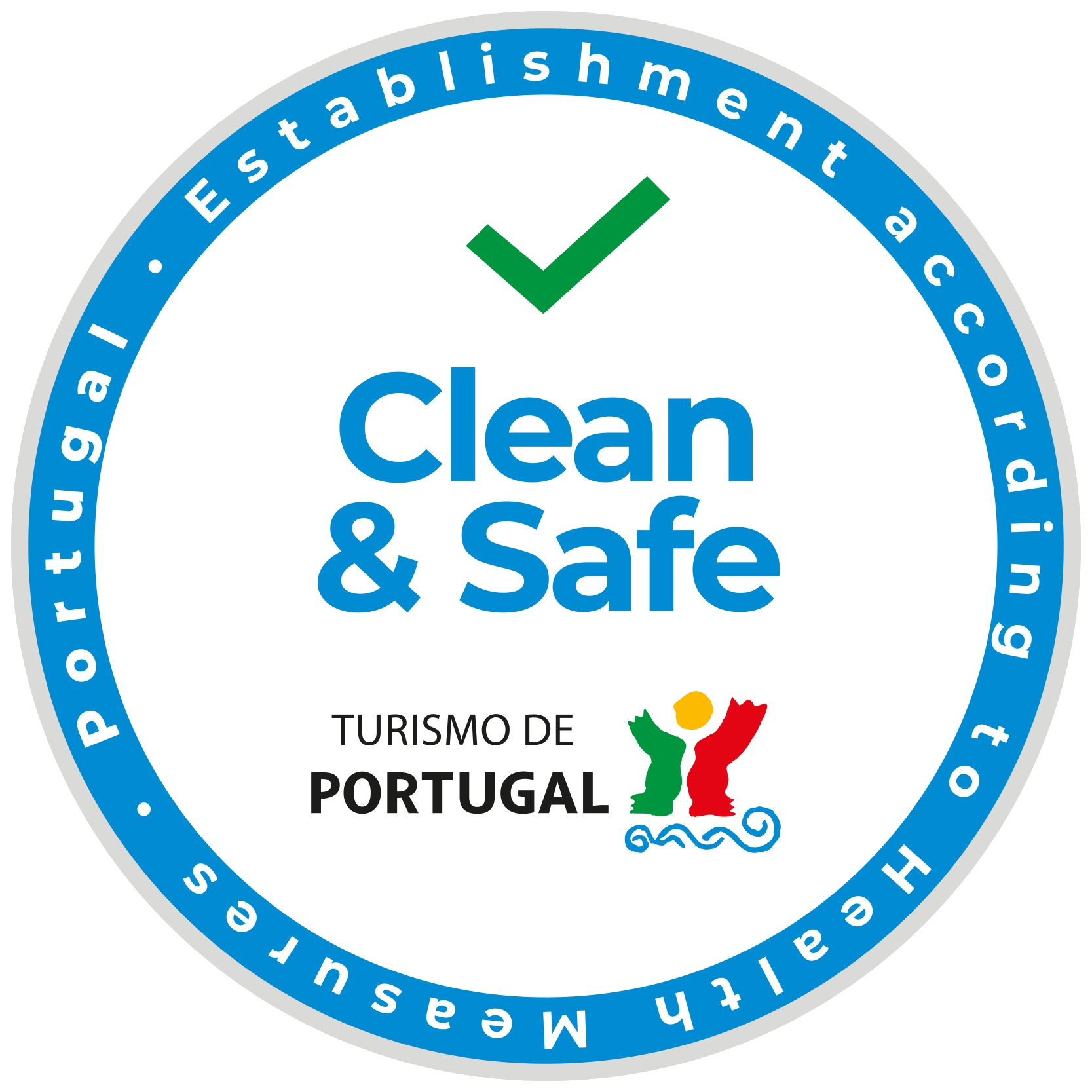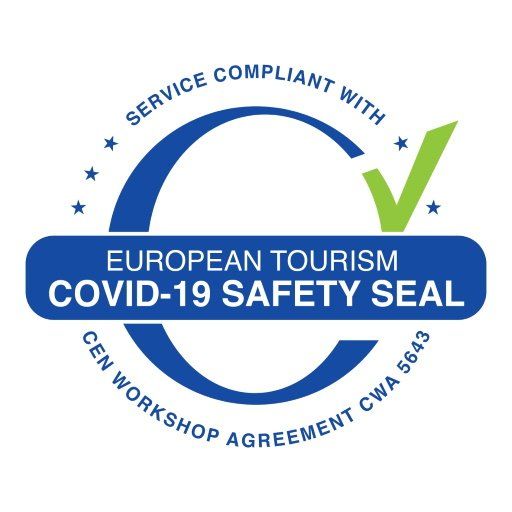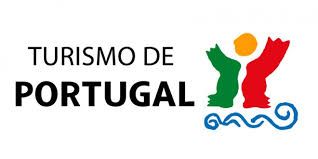Covid-19 Prevention and Contingency Plan
Covid-19 Prevention and Contingency Plan
1. Framework and Scope
According to the decree-law 13/2009, the employer is responsible for creating the best health conditions and organizing the Health and Safety at Work Services, and must ensure the conditions on an ongoing basis, based on preventive measures. .
In addition, the organization has an important social role in protecting the health and safety of its workers and their customers.
Likewise, the relevance and application of this document is important for the smooth running of the company, as well as for the prevention and control of infection, and for limiting the country's negative, economic and social impact.
Thus, this establishment declares to fulfill the requirements defined by Turismo de Portugal, in accordance with the guidelines of the Directorate-General for Health, which allow it to be considered a HEALTHY & SAFE Establishment.
2. Viruses and their transmission
COVID-19 (SARS-COV-2) affects the respiratory system and can cause severe respiratory infections, such as pneumonia. Thus, the main symptoms detected are: fever (≥ 38ºC); cough; breathing difficulty, namely, air loss. Sore throat, headaches and / or muscle pain, tiredness and runny nose can also occur.
In addition, the main transmission of the virus is people, which can occur in the following ways:
- Direct contact with infectious secretions;
- Respiratory droplets;
- Aerosols in therapeutic procedures that produce them.
3. General Prevention Measures
- Daily temperature measurement (without registration);
- Symptom surveillance;
- Avoid contact with people at risk, such as chronic patients or those with respiratory infections;
- Avoid touching your eyes, nose or mouth with your hands;
- Wash your hands frequently, paying special attention to indoors, in public health spaces and whenever you come into contact with common surfaces or equipment;
- Always wash your hands before each meal and after using common equipment, as well as whenever you blow, sneeze or cough;
- Hand hygiene must be done with soap and water for at least 20 seconds by rubbing the fingers, space between them and the initial part of the arm. In addition, antiseptic solutions composed of more than 70% ethyl alcohol can also be used;
- Adopt respiratory etiquette measures, such as: Coughing or sneezing into the fl exed forearm or using a disposable handkerchief, which must then be immediately thrown away after use;
- Adopt a social conduct, changing the form of compliance, avoiding, whenever possible, close contact (handshakes, kisses, shared jobs, face-to-face meetings and sharing of food, utensils, glasses and towels);
- Avoid touching areas of common use (chairs, handrails, handles, etc.);
- Daily and reinforced cleaning of the dining spaces, as well as the respective utensils, equipment and surfaces common to employees. This space should be alternated so that no more than 1 person is in the same place, in order to avoid direct food handling as much as possible;
- Hygiene and disinfection of means of transport, after each activity, and in accordance with the rules applicable to each type of transport;
- Whenever possible, the cleaning of the facilities and equipment will be done through cleaning equipment for single use, taking as an example the paper towels for cleaning the handrails. If it is not possible to use single-use instruments, they should be disinfected after each use using sodium hypochlorite (bleach), avoiding dry cleaning and using a vacuum cleaner;
- Cleaning and sanitizing the surfaces where employees circulate and objects of common use (counters, light switches, door handles, pan faucet, cabinet handles, computers, etc.), ensuring the control and prevention of infections;
- Daily record of cleaning and sanitizing;
- Air renovation of common and closed spaces regularly;
- The use of PPE (Personal Protective Equipment) is mandatory on the following occasions:
- Masks: For employees who are on company premises and vessels.
- Gloves: For crew whenever there is catering on board and for cleaning the spaces used by customers during the activity.
4. Prevention Measures at Facilities
4.1. Office
- The company has enough personal protective equipment for active workers and customers;
- Supply of alcohol-based, single-use cleaning wipes moistened with disinfectant at the entrance of the company;
- Telephones and mobile phones must be for personal use and must be disinfected in the entire contact area with the device after each use;
- Computers, keyboards and mice must be cleaned after daily use;
- The working spacing between employees should be 1.5m to 2m;
- Before and after using the printer, employees must wash their hands, as well as door handles and switches;
- Avoid altering work teams (crew);
- Avoid using air conditioning inside the company's facilities;
- In the public service space, it will only be possible for 2 customers to stay, and the use of a mask is mandatory for both;
4.2. Boats
- Hygiene and disinfection of the keys of each vessel;
- Basket lined with plastic bag for masks, gloves and another for waste;
- Washing and disinfecting hands before starting treatment, in front of the client;
- The sanitary facilities of each boat have liquid soap and disposable paper towels;
- Mandatory use of a mask;
- At the end of each mandatory service cleaning and disinfection of the vessels and, later, locked.
5. Recommendations:
- Washing of clothing at high temperatures (about 60º) used in the work activity by employees and customers;
- Disinfection of the bucket and mop at the end of each use, which must be different for each area of use, for example the bucket and mop used in the pantry or on a boat must not be the same for cleaning the remaining spaces;
- For the floor it is advisable to wash with hot water and common detergent, followed by disinfection with bleach and water (minimum frequency twice a day);
- In the sanitary facilities, the washing must be carried out with a 2 in 1 product (composed of detergent and disinfectant);
- Presence of alcohol-based hand sanitizers in each vessel, to supply the customer, whenever justified;
- All material used in carrying out the activities must be disinfected after each use;
- Upon arrival of the vessel, the crew should encourage customers to disinfect their hands and take off their shoes, leaving their shoes at the entrance of the boat and where they should place their belongings.
6. Contingency Plan
In view of the preventive measures that will be applied and the respective recommendations, we will execute the contingency plan following all the guidelines of the DGS (General Health Board).
- COMPANY : FEELDOURO, LDA
- ESTABLISHMENT : Rua da Praia (Douro Marina) - Store 8 and Employer Vessels
- RESPONSIBLE FOR CONTACTING HEALTH AND HYGIENE ENTITIES AND WORK SAFETY : Juliana Correia (+351 915 915 098); Beatriz Magalhães (+351 220 990 922)
- RESPONSIBLE / RESPONSIBLE FOR MONITORING / ASSISTING WORKERS WITH SYMPTOMS : Juliana Correia (+351 915 915 098); Beatriz Magalhães (+351 220 990 922)
6.1. Identification and Procedure of a Suspected Infection Case
In the event that there is a case of infection by COVID-19, if the worker is the infected person, he will have to alert his direct superior or the designated responsible person, preferably by telephone and go to the established isolation area.
In this way, the worker will have to contact the SNS (national health service), and if it is an unsuspected case, he will have to inform the employer of the non-validation and he will communicate all the information to the doctor of the responsible worker. In case of being suspicious, the SNS24 will contact the Medical Helpline and an assessment of the case will be made by the SNS 24, which will then communicate to the worker.
With regard to passengers / customers, the alert must be given by the worker, the designated responsible person or his superior, alerting him to the situation so that the latter can activate the competent health authorities.
6.2. Delimitation of the Isolation Area
The isolation area established will be a vessel (Greenline 33 - Rosé), with the support of a kitchen, a living room, a bedroom and a bathroom properly equipped with a toilet, washbasin, soap, water and paper towels, with smooth linings. easy washing and sanitizing.
The suspected case will have at its disposal plastic water bottles, wafers, antiseptic solution, disposable paper towels, disposable gloves, surgical mask) non-manual waste container, plastic bags with ties and thermometer.
In addition, the suspect will have access to the contacts of the health authorities, INEM, SNS24 and the person responsible for activating the action plan.
6.3. COVID-19 Infected Action Plan
If it is confirmed that the individual is infected with COVID-19, the employer must reinforce the cleaning and disinfection of the surfaces / objects and areas most likely to be contaminated, taking as an example: those frequently handled and used by the confirmed patient.
Thus, the following instructions should be analyzed:
- Prohibition of the isolation area until its decontamination, which may be raised by the local health authority;
- Cleaning and disinfection of the isolation area;
- Strengthening the cleaning and disinfection of the patient's workplace;
- Collection of residues from the confirmed case in a plastic bag, which must then be closed and sent to a licensed operator for the management of biohazardous waste;
- The local health authority, in coordination with the occupational physician, will inform the employer of the health status of your worker and of close contacts.
6.4. Surveillance of Nearby Contacts
After confirming the suspected case of infection with the new virus, a surveillance of all those who have been in contact with the infected person in the last 12 to 14 days should be carried out, such as:
- Usual close contacts (eg co-workers, friends and family);
- List of customers transported in the period indicated above.
Workers at high risk of exposure:
- Daily self-monitoring of COVID-19 symptoms;
- Monitoring and monitoring of the situation by the occupational physician;
- Restrict social contact to what is essential;
- Do not travel;
- Be contactable within 14 days, since the last exposure, for active monitoring.
Workers with low risk of exposure:
- Daily self-monitoring of COVID-19 symptoms;
- Monitoring of the situation by the occupational physician.
- If symptoms similar to the virus in question are observed, point 5.1 of this document will be implemented. If no symptoms are observed after 14 days, the situation will be closed.
6.5. Definition of Responsibilities
All workers must report to those responsible for contacting health authorities and trigger the action plan, the disease situation compatible with the symptoms of covid-19. It is important to note that it is extended to all those who use the company's facilities, from customers to suppliers.
If the situation is detected and / or communicated to the responsible person or persons responsible, he / she will have the duty to accompany and monitor the situation according to the procedures indicated in the present plan, always providing assistance to the infected suspect.
7. Hygiene and Occupational Safety Contacts and Health Services
RESPONSIBLE: Juliana Correia (+351 915 915 098); Beatriz Magalhães (+351 220 990 922)
EXTERNAL WORK MEDICINE SERVICES: Headquarters Continuous Action (+351 255 781 387)
NATIONAL HEALTH SERVICE: 808 24 24 24
8. Prevention Equipment and Products
| PRODUCTS | LOCAL |
|---|---|
| Alcohol-based antiseptic solutions and paper wipes. | Administrative facilities / service area and vessels |
| Wet wipes and disposable masks for social use. | Administrative facilities / service area and vessels |
| Disposable paper towel for drying hands and cleaning common utensils and paper napkins. | Boats and dining area |
| Surgical mask and disposable gloves. | Administrative facilities / service area, vessels and isolation area |
| Equipment and cleaning products (not disposable), hygiene and disinfection. | Administrative facilities / service area and vessels |
| Waste container with non-manual opening and plastic bags with tie | Cup and isolation area |
9. Information and Training for Employees
All workers are aligned and prepared to act at any time with the Prevention and Action Plan, being available in digital format on the company's intranet and also on the website (www.feeldouro.com). In addition, training, sensitization and awareness-raising activities will be carried out for workers, with topics such as: Health Policy, New Policies and Operating Procedures; Difference between cleaning, hygiene and sterilization; Individual responsibilities and control measures.
Website built by Horizonte Digital | All rights reserved | FeelDouro, Lda







